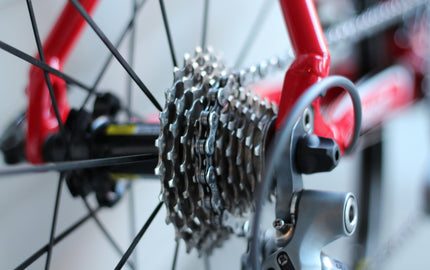
Understanding the Role of a Lead-out Man in Road Cycling
Understanding the Role of a Lead-out Man in Road CyclingIn the fast-paced world of road cycling, where every second counts, the lead-out man, plays a pivotal and sacrificial role. Their...

Understanding Gear Ratio: A Comprehensive Guide
Gear ratio, often discussed in the context of bicycles, plays a crucial role in optimizing cycling performance. But what exactly is gear ratio, and why is it so frequently emphasized in discussions about cycling equipment? In this article, we'll delve into the intricacies of gear ratios, exploring their significance, calculation, and practical applications in cycling. What is Gear Ratio? At its core, gear ratio refers to the relationship between the number of teeth on the front chainring (crankset) and the rear cog (cassette) of a bicycle. This numerical value, obtained by multiplying the number of teeth on the front chainring by those on the rear cog, determines the gear ratio. For instance, if the front chainring has 2 teeth and the rear cog has 9, the resulting gear ratio would be 2:9, commonly referred to as an 18-speed gear system. Teeth on both the front chainring and rear cog are typically denoted by the unit 'T'. For example, 11T signifies a component with 11 teeth. It's worth noting that the largest cog on either the front or rear is considered the gear with the most teeth. Understanding Gear Ratio in Practice Gear ratio, essentially, reflects the mechanical advantage provided by different gear combinations. A larger rear cog relative to the front chainring (i.e., a lower gear ratio) facilitates easier pedaling, ideal for climbing hills or generating acceleration from a standstill. Conversely, a smaller rear cog paired with a larger front chainring (a higher gear ratio) enables higher speeds at the expense of increased pedaling effort, suitable for flat terrain or downhill riding. When pedaling, the gear ratio influences the revolutions of the rear wheel for each rotation of the pedals. This relationship directly affects the speed and effort required during cycling. Practical Considerations Choosing the appropriate gear ratio depends on various factors, including terrain, riding style, and personal preference. Cyclists often experiment with different gear combinations to find the optimal setup for their needs. For example, on flat terrain or downhill sections, cyclists may prefer a high gear ratio to maximize speed. Conversely, when facing steep inclines or challenging climbs, a lower gear ratio offers the necessary mechanical advantage to tackle the ascent with less effort. Selecting Gear Ratios for Different Riding Conditions In practical terms, adjusting gear ratios allows cyclists to adapt to changing terrain and optimize performance: Flat Terrain and Downhill Riding: Opt for higher gear ratios for increased speed and efficiency. Uphill Climbs: Lower gear ratios provide the mechanical advantage needed to conquer steep inclines with less exertion. Continuous Climbing: Gradually transitioning to lower gear ratios can help maintain a steady cadence and conserve energy during sustained climbs. Conclusion In summary, gear ratio is a fundamental aspect of cycling that significantly influences performance and efficiency. By understanding the principles of gear ratio and its practical implications, cyclists can make informed decisions when selecting gear combinations to suit various riding conditions. Whether navigating challenging climbs or sprinting on flat roads, mastering gear ratio optimization empowers cyclists to enhance their riding experience and achieve their performance goals.

Unlocking Speed: Tips for Enhancing Your Cycling Performance
Have you ever wondered how fast you can ride a road bike? Online experts often tout an average speed of 40 kilometers per hour (km/h) as a benchmark. But what...

Exploring the Diverse World of Bicycles: A Guide to Different Types of Bikes
Bicycles come in various shapes, sizes, and specialized designs, each tailored to different riding styles and environments. Let's take a closer look at some of the most popular types of...

Can Cycling Really Help You Lose Weight?
The age-old question persists: can cycling truly help you lose weight? The answer depends on various factors, including the intensity of your rides, your calorie intake, and the type of...

Mastering Clipless Pedals: Avoiding Zero-Speed Falls and Maximizing Efficiency
Have you ever experienced that awkward moment when you come to a stop while cycling and forget to unclip from your pedals? This classic mishap, known as a zero-speed fall,...

Exploring the Benefits of Electric Assist Bikes for Cycling Enthusiasts
Have you ever heard the saying, "The end of a traditional bike leads to a road bike, and the end of a road bike leads to an electric assist bike"?...

Mastering No-Hands Cycling: The Art, Benefits, and Risks Explained
The allure of cycling extends beyond mere transportation; it's a symphony of skill, balance, and freedom. One fascinating aspect of cycling is the art of "no-hands" riding, where riders let...
Subscribe to our newsletter
Add a short description for this section






























































